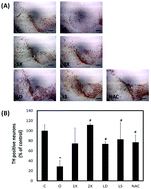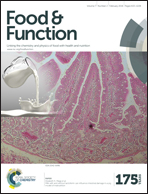The ameliorative effect of Monascus purpureus NTU 568-fermented rice extracts on 6-hydroxydopamine-induced neurotoxicity in SH-SY5Y cells and the rat model of Parkinson's disease
Abstract
Oxidative stress and neuroinflammation underlie the major pathogenesis in Parkinson's disease (PD). Antioxidants are known to protect against the degeneration of dopaminergic neurons. Monascus purpureus-fermented rice, a traditional Chinese medicine as well as a health food, includes multifunctional metabolites. The present study was designed to investigate the effects of the antioxidant-containing M. purpureus NTU 568-fermented rice extract (extracted with 50% ethanol, so called R50E) in 6-hydrodopamine (6-OHDA)-induced neurotoxicity in vitro and in vivo. In vitro, treatment with R50E reduced 6-OHDA-induced SH-SY5Y cell death. In vivo, two doses of R50E (5.5 and 11.0 mg kg−1) were administered for a period of 28 days following 6-OHDA-induced lesioning. The administration of R50E reduced parkinsonian motor dysfunction and the number of tyrosine hydroxylase (TH)-immunoreactive neurons present in 6-OHDA-induced lesioned rats. Moreover, the administration of R50E reversed the elevation of reactive oxygen species (ROS) and malondialdehyde (MDA) levels and promoted the activity of antioxidant enzymes such as superoxide dismutase (SOD), catalase, glutathione reductase, and glutathione peroxidase via down-regulation of p47 phox, NOX1, and NOX2 expression in the 6-OHDA-lesion rats. Furthermore, treatment with R50E attenuated nitric oxide (NO) and tumor necrosis factor (TNF-α) levels in the 6-OHDA-lesion rats. In conclusion, R50E may prevent neurodegeneration via anti-oxidative and anti-inflammatory mechanisms, suggesting its potential therapeutic value for PD treatment. This is the first study for evaluating the neuroprotective effects of red mold fermented products in PD models.


 Please wait while we load your content...
Please wait while we load your content...